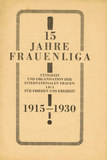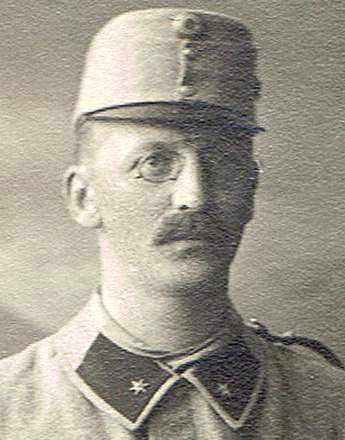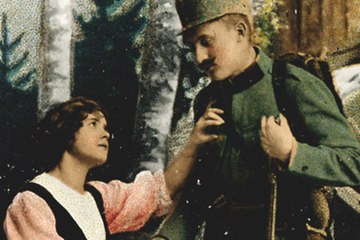‘… and tomorrow we will start cheerily canvassing for peace.’
-

“15 years of the International League of Women for Peace and Freedom”, brochure
Copyright: Sammlung Frauennachlässe, Institut für Geschichte der Universität Wien
Partner: Sammlung Frauennachlässe, Institut für Geschichte der Universität Wien -

Handwritten notes by Matilda Hanzel about the causes of the war
Copyright: Sammlung Frauennachlässe, Institut für Geschichte der Universität Wien
Partner: Sammlung Frauennachlässe, Institut für Geschichte der Universität Wien
Mathilde Hanzel, whose letters reflect a critical attitude right from the start of the war, took an active role in various peace-promoting initiatives from 1916/1917.
She did this primarily within the confines of the Allgemeiner Österreichischer Frauenverein (AÖFV; General Austrian Women’s Association), from which she had resigned in 1914 but with which she continued to have close ties.
Within the first women’s movement in Austria the AÖFV was the most vocal wing in its support of the peace initiatives during the First World War. In addition to issuing numerous publications promoting these initiatives, it organized several peace conventions in Vienna in November and December 1917. Mathilde Hanzel, who attended these meetings, also joined the association’s Peace Party, which was founded in 1917.
In a letter to her husband dated 23 January 1918 she describes one of these meetings: ‘[…] and then I went to the peace convention called by the General Austrian Women’s Association. […] so great was the enthusiasm of the audience that they drummed with their feet, making the large auditorium thunder. […] I of course joined the Peace Party, to which in my heart I have always belonged, paying my dues (1 K(rone)instead of 2 K), and also bought a pretty badge, a little length of white ribbon with ‘Peace Agreement’ printed on it in green, which I wear, of course. In the tram it was eyed thoughtfully but without comment.’
Mathilde Hanzel also took part in an initiative known as ‘Drei Heller für den Frieden’ (Three Pennies for Peace), organized by Der Abend, a newspaper that was, as historian Petronilla Ehrenpreis has described, critical of the government, ‘constantly clashed with the censorship authorities and was intermittently banned’. At the end of October 1917 ‘it called on its readers to send postcards to the editor in support of demands for a peace agreement in line with foreign minister Czernin’s proposals’. She wrote about this to her husband on 23 October 1917: ‘Darling, today in the Abend there was an appeal to vote for an immediate peace agreement as proposed by Count Czernin. I immediately voted for it […] and tomorrow we will start cheerily canvassing for peace. At last!’
In her letters to her husband Mathilde Hanzel repeatedly gives detailed accounts of her pacifist ideas and active support of peace initiatives. However, these topics only ever appear in her side of the correspondence; Ottokar Hanzel never comments on them. And in one of Mathilde Hanzel’s letters she writes: ‘You don’t want to talk about peace, so be it […].’ As an officer, her husband held fast to the attitudes befitting his rank which made talk about peace difficult to reconcile with the officially demanded values of honour and duty, concepts that he repeatedly touches on in his letters.
Translation: Sophie Kidd
Ehrenpreis Petronilla: Kriegs- und Friedensziele im Diskurs. Regierung und deutschsprachige Öffentlichkeit Österreich-Ungarns während des Ersten Weltkriegs, Innsbruck/Wien/Bozen 2005
Flich, Renate: Frauen und Frieden. Analytische und empirische Studie über die Zusammenhänge der österreichischen Frauenbewegung und der Friedensbewegung mit besonderer Rücksicht des Zeitraumes seit 1960, in: Rauchensteiner, Manfried (Hrsg.): Überlegungen zum Frieden, Wien 1987, 410-461
Rebhan-Glück, Ines: „Wenn wir nur glücklich wieder beisammen wären …“ Der Krieg, der Frieden und die Liebe am Beispiel der Feldpostkorrespondenz von Mathilde und Ottokar Hanzel (1917/18), Unveröffentlichte Diplomarbeit, Wien 2010
Zimmermann, Susan: Die österreichische Frauen-Friedensbewegung vor und im Ersten Weltkrieg, in: Forum Alternativ (Hg.): Widerstand gegen Krieg und Militarismus in Österreich und Anderswo, Wien 1982, 88-96
Quotes:
„and tomorrow we will start cheerily ...“: Mathilde Hanzel to Ottokar Hanzel, 23.10.1917, Sammlung Frauennachlässe, Nachlass 1, Institut für Geschichte der Universität Wien (Translation: Sophie Kidd)
„[…] and then I went to the peace convention ...“: Mathilde Hanzel to Ottokar Hanzel, 23.01.1917, Sammlung Frauennachlässe, Nachlass 1, Institut für Geschichte der Universität Wien (Translation: Sophie Kidd)
„constantly clashed with the censorship ...“: quoted from: Ehrenpreis Petronilla: Kriegs- und Friedensziele im Diskurs. Regierung und deutschsprachige Öffentlichkeit Österreich-Ungarns während des Ersten Weltkriegs, Innsbruck/Wien/Bozen 2005, 222
„it called on its readers to send postcards ...“: quoted from: Ehrenpreis Petronilla: Kriegs- und Friedensziele im Diskurs. Regierung und deutschsprachige Öffentlichkeit Österreich-Ungarns während des Ersten Weltkriegs, Innsbruck/Wien/Bozen 2005, 223
„Darling, today in the Abend there was an appeal ...“: Mathilde Hanzel to Ottokar Hanzel, 23.10.1917, Sammlung Frauennachlässe, Nachlass 1, Institut für Geschichte der Universität Wien (Translation: Sophie Kidd)
„You don’t want to talk about peace …“: Mathilde Hanzel to Ottokar Hanzel, n. d., Sammlung Frauennachlässe, Nachlass 1, Institut für Geschichte der Universität Wien (Translation: Sophie Kidd)
-
Chapters
- How does a collection of letters come to be stored in an archive?
- The protagonists: Mathilde Hübner and Ottokar Hanzel
- Love, marriage, career
- The separation begins
- ‘War fever’ versus the longing for peace
- Italy’s ‘betrayal’ in 1915
- ‘… surely this war must end some time?!’
- ‘… and tomorrow we will start cheerily canvassing for peace.’
- Black marketeering, profiteering and self-subsistence
- A love affair in wartime
-
Chapters
- “Lay down your arms” – Bertha von Suttner, the most prominent Austrian peace activist
- ‘The Austrian Society of Friends of Peace’– a brief episode?
- Alfred H. Fried and the peace movement during the war – censorship and derision
- ‘The League of Austrian Women’s Associations’ and the end of peace activities
- The Hague or the “betrayal” of the warring nation
- ‘… and tomorrow we will start cheerily canvassing for peace.’
- Peace and social issues
- The idea of the ‘peace-loving woman’?
- Peace and the Church – Thou shalt not kill!
- Peace and language – peace and the Esperanto movement
- Para Pacem – an Austrian peace movement with a difference
- Individual peace initiatives – Julius Meinl and Heinrich Lammasch
- ‘… surely this war must end some time?!’














